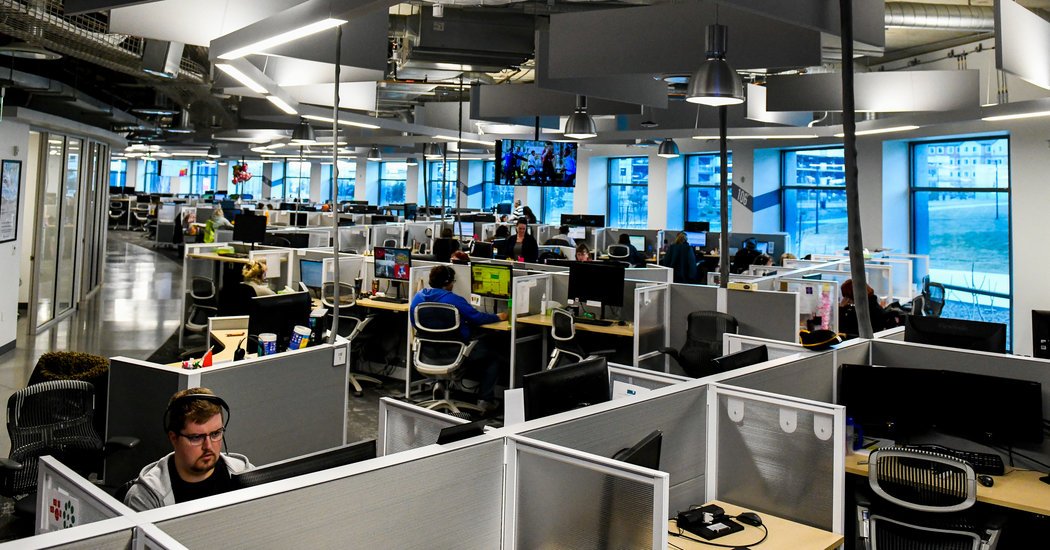A growing number of tech companies are pushing research labs and other far-reaching engineering efforts closer to the boss. The point is unmistakable: What they are doing matters to the C.E.O. It may even be the future of the company.
“The world is moving faster and faster. It is being driven by technology and innovation,” said John Kotter, an emeritus professor at Harvard Business School who has written several books on business leadership. “And a lot of these businesses are concluding that the speed of technological innovation should be the heart of everything.”
Credit
Ryan Young for The New York Times
A year ago, the Google Brain team of mathematicians, coders and hardware engineers sat in a small office building on the other side of the company’s campus. But over the past few months, it switched buildings and now works right beside the loungelike area where Mr. Pichai and other top executives work.
Jeffrey Dean, the celebrated Google engineer who oversees the Brain lab, is a short walk from Mr. Pichai. So are Ian Goodfellow, the researcher behind a new A.I. technique that generates lifelike images on its own, and Norm Jouppi, who explores ways of accelerating A.I. research through a new breed of computer chip.
“Any C.E.O. thinks a lot about where people are sitting — who they can walk around and have casual conversations with,” said Diane Greene, who oversees Google’s cloud computing team and sits on the board of Alphabet, Google’s parent company. “It is a very significant statement that he has moved that group right next him.”
Google is placing big bets on the A.I. being explored by researchers like Mr. Goodfellow. Many questions still hang over the progress of this research. But Mr. Pichai and the rest of the Google leadership hope it will accelerate the evolution of everything from smartphones and home appliances to internet services and robotics.
To Mr. Byrne, shaking up the seating chart at Overstock was a bit like a common management tactic in the military, when an officer will work closely with a small “command initiatives group” that is considerably more nimble than the rest of the organization.
“We were getting bureaucratic,” Mr. Byrne said. “And this was a way of creating added competition outside the bureaucracy.”
These big companies are trying to duplicate the vibe of a Silicon Valley start-up, where the boss is next to everyone. As start-ups grow, they often put key technology teams next to the chief executive. Ms. Greene, who was the chief executive of the software company VMware, said she had always made a point of sitting beside the top engineers because they saw the company’s future.
There are limits to these arrangements. When Facebook built a team to explore the future of virtual reality on its vast social network, it made a similar desk move. The group is no longer seated next to Mr. Zuckerberg. Facebook said this was because the group had grown too large. But across Silicon Valley, virtual reality is no longer the buzziest of topics. That honor belongs to artificial intelligence.

Credit
Alex Goodlett for The New York Times
Where you sit has mattered for years at Facebook. The company’s ad group traditionally sat far away from Mr. Zuckerberg. But after Facebook went public and started a big push for revenue, key members of the ad team moved next to the boss, said Antonio García Martínez, who wrote a book about his experiences inside Facebook.
At Overstock, Mr. Byrne walks past his small research team every time he leaves his office. Like Ms. Greene, he sees this as an opportunity for spontaneous interaction. The team members can discuss their work with him, and Mr. Byrne, a doctor of philosophy with a long history of unorthodox business choices, will share his far-reaching ideas with them. And he gets to hear, without the pressure of a formal presentation, what the engineers are excited about.
“It was undeniable that proximity sparked conversation,” said Judd Bagley, a kind of roving technologist and strategist who once worked in this group. “Patrick prides himself on being able to walk up to anyone at the company, say ‘hello,’ and occasionally even eat french fries off the plate on their desk.”
Through OLabs, Overstock became the first major retailer to accept payment in the Bitcoin digital currency, and the lab eventually produced a company spinoff that seeks to apply the Bitcoin ethos to financial trading. Now, in an echo of the A.I. labs at Google and Facebook, the operation is focused on machine learning, which involves systems that can learn tasks on their own by analyzing large amounts of data.
If a chief executive is close to these researchers, he or she is learning from them. But the boss is also showing them how important they are to the company. That is enormously valuable for engineers and mathematicians who are not necessarily generating immediate revenue, said Kevin Quennesson, a start-up executive who ran an A.I. team at Twitter.
He also warned that companies risked putting too much pressure on researchers to produce results from work that was, by definition, a trip into the unknown. Amid so much spontaneous conversation with the chief executive, Mr. Bagley said, it is sometimes difficult to tell the difference between “the formal direction and informal brainstorming.”
Status at Facebook was defined by how close your desk was to Mr. Zuckerberg, Mr. Martínez said. And if you were close to the boss, other groups resented you.
Priorities also tend to ebb and flow. At Overstock, a new Bitcoin project will squeeze in beside OLabs. And at Facebook, the A.I. lab is no longer side by side with Mr. Zuckerberg because it also grew too large.
Still, this work is particularly important to the company as it works to ensure “the safety and integrity of our community” — which has become Facebook code for guarding against false, misleading or dangerous activity on its social network, Mr. Schroepfer said. And the A.I. team is still only a short walk from Mr. Zuckerberg.
By CADE METZ
https://www.nytimes.com/2018/02/19/technology/ai-researchers-desks-boss.html
Source link

